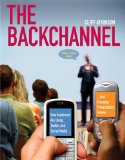Women and the backchannel on This is Rachel Andrew talks about the backchannel comments directed at female presenters at the recent 200th Boagworld podcast. A couple of good ideas were proposed to deal with the issues raised.
The chatroom on the Boagworld show was essentially a backchannel, and similar issues have happened in conference backchannels in recent months, I believe this is something that needs to be addressed in two ways. Firstly, the community need to be ready to stamp on this kind of behaviour as soon as it is seen. If you are in a channel that starts to go down this line make sure you are not contributing to it, and speak up against it. Can you help to turn the general mood to something more positive? Or offer constructive criticism? I’m certainly not suggesting we shouldn’t be able to disagree with a female speaker! Quite the opposite, we should be dealing with everyone in exactly the same way, I’m not a fan of positive discrimination either.
Secondly I think there are technical solutions to some of this. If you have a live chat or backchannel, people should not be able to post anonymously, or behind nicknames that do not link back to a real person. As a thought perhaps we could have a system where everyone has to sign in with Facebook Connect? Facebook is about real names, real people. Would yesterday’s commenters have been happy for their comments to go out next to their photo, real name and the company they work for? In a conference situation the organisers usually have all those details, so a system can be created that ensured that comments only go out on a live channel that are identified to individuals. There are some people who will quite happily stand behind unpleasant comments but I would suggest they are far fewer than those who switch personalities when they can hide behind an anonymous nickname.
I think her second idea would create much more success than the first. Everyone already knows they need to behave. The chances of getting them to actually behave are greater when there’s full transparency about who is acting like a juvenile jerk.
The reference to “similar issues” in the quote above refers to a backchannel event that gave danah boyd problems. Since I’m very excited about the fact that she is one of the keynoters at the upcoming SXSW Interactive conference and am really looking forward to her talk, I’ve been wondering about how that will go. Audiences at SXSW have been known to disrupt a keynote in the past using the backchannel. In one case the backchannel ire was directed at a woman. However, men have been on the receiving end of bad mouthing from the backchannel, too.
Related Links:
